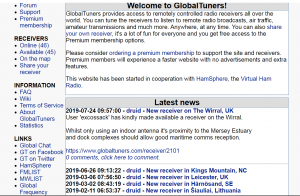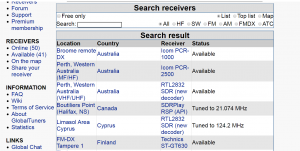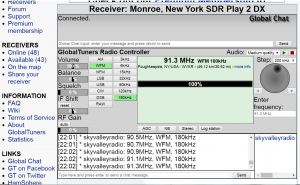
Our first blog on Software-Defined radio (SDR) introduced this marvelous new technology to readers & concluded with the fact that there are units that are available online to tune remotely by listeners anywhere using one’s computer or hand-held wireless device. There are 3 web accessible portals for tuning these that are free & don’t require installation of specialized, proprietary software to access & operate. The first & original system was developed by Pieter-Tjerk de Boer & is called “WebSDR”. These receivers located throughout the world can be accessed via a map in which users can activate with a mouse-click. The 2nd site that is popular & user-friendly is called “Global Tuners” & as of this posting contains 46 online receivers that can be tuned. The third site, most popular of all & the easiest to use is the world-wide “KiwiSDR” receivers which currently are the most prolific throughout the planet. We will devote a blog to each of these to demonstrate their usage & give you a chance to try one. So join me now as we get our hands on one of these SDRs. But first an explanation about antennas & performance of individual receivers.

Since these online SDR’s are all privately owned, implemented & paid for by individuals, it stands to reason that any particular receiver’s performance specialties will reflect the interests of that person as to what parts of the radio spectrum have best reception. Like any other radio, an SDR requires an efficient antenna to receive well & as we all know – not all antennas are designed to work at all frequencies in the radio spectrum. For example a sensitive antenna for FM broadcasting or TV channel frequencies does not necessarily perform well on the short-wave or AM spectrum. Likewise, an antenna designed for short-wave listening is more or less useless at the VHF & UHF frequencies encompassing FM broadcasting, TV channels or 2-way radio communication such as that used by first-responders or businesses employing 2-way radio usage in their day to day business. All receivers on all 3 sites clearly state what antenna or antennae are connected to advise the online user what to expect or not expect regarding that receiver’s
performance. With this in mind, users need to choose online tuners in locations that have the desired portions of the radio spectrum one is interested in tuning & listening to – be it AM, short-wave, FM, VHF/UHF communications or TV channels.

We’ll start with the easiest of the online SDR receivers to use & that is “Global Tuners”. The URL link is:
Although “Global Tuners” has only a limited group of receivers, those offered have the most diverse reception opportunities of the free online tuners, specifically access to FM stations heard at the locations identified. Unlike the other two, with “Global Tuners” only one person can be tuning the radio at any given time, although it’s possible to log on to one of these in use. SDRs in use vs. those that are freely available for tuning are shown & constantly refreshed as users come & go. Etiquette suggests one not log on & re-tune a receiver already in use. To again reiterate, SDR receivers are actual radios, NOT online stream links or portals. The site is free to use & those choosing to register for a free account always get preferred use over ‘guests’ when accessing these radios. Some are only available to those who choose to sign up for an account. Premium membership is available for those who wish to avoid site ads or want first priority usage of these radios. Once onsite & choosing “Online Radios” you’ll see a list of the receivers & those that are currently in use & tuned to a specific frequency. Click on your receiver of choice:

You’ll then see a description of the receiver, it’s location & antennas installed for specific portions of the radio spectrum. Click on “Open this Receiver” :

Here is a screenshot of the main tuner interface. Our first example receiver is the SDR located in Marahau, Tasman Bay, NZ & is tuned to 531 kHz in the AM band. Note “AM” button is selected. AM tuning steps in North America use 10 kHz spacing (540, 550, 560 etc) but elsewhere in the world 9 kHz steps are used. “Step” is selected as 10 kHz but needs to be changed for use in New Zealand. Change “Step” to 9 kHz from the drop-down menu. Receiver bandwidth is set to “5.1” For “FM” one can choose “NFM”. Frequency can be entered directly or users can actual twirl the tuning knob as on a real receiver. A chat box is on the bottom of the interface, useful when more than one user is present. Have fun & experiment – you cannot “break’ or damage the receiver. Each time a new user logs on or if you ‘refresh’ the page, default settings determined by the SDR owner/operator return. This often includes a pre-determined frequency & mode – such as “AM” or “NFM” Don’t be intimidated by controls you don’t understand or know how to use. The radio can be used at the most simple of levels. Have fun!

Our 2nd Global Tuner example is one of the receivers located at Monroe NY. It is tuned to 91.3 WVKR. Mode is selected as “WFM”. Receiver bandwidth is set to “180 kHz” – a typical narrow bandwidth for FM broadcasting. Tuning “Step” is set to 200 kHz. This will tune the receiver in 200 kHz steps as 88.1, 88.3, 88.5 etc. Enter frequency directly written as “91.3 mHz” or use the tuning knob or < & > to scan in steps.

Now that you’ve mastered & had some fun with “Global Tuners”, next blog will examine a more detailed & sophisticated SDR receiver system, but just as easy to use & have fun with.
retired broadcaster: on-air, MD, PD, asst PD, Prod Mgr, IT, station technician/engineer, pioneer Internet webcaster, station installation/maintenance; 12 years in commercial radio, 17 years volunteer in campus/community radio in B.C., Alberta & Wash. Amateur radio operator & “DXer” specializing in AM night-time DX, short-wave DX/listening & remote SDR DXing/listening





COMMENT GUIDELINES | "What Happened To My Comment?" | post an OFF-TOPIC COMMENT